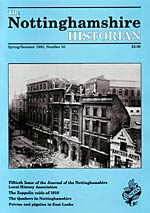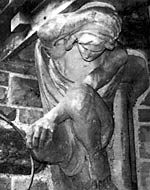News for Winter 2008
Editorial
As I start my task as Editor of the Newsletter I must sincerely thank Janice Avery for the excellent work she did during her period in the editorial hot seat. Under Janice's stewardship the Newsletter developed and has provided our members with excellent information about the Society, its past activities, and giving tasters of those to come. Janice took over the reins with issue 19 in Spring 2000. Rest assured, there will continue to be the same seeking for contributions amongst you all; not only the regular stalwarts who produce reports of meetings, photographs and future events, but from other members. In connection with the latter, I would be interested in anything in which members have been involved, whether directly in Thoroton Society events or not. If there is a Thoroton connection, no matter how tenuous, please let me know about it. My contact details are given at the end of this issue.
The Thoroton Response Group
In the last issue of this Newsletter, the TRP reported that it had commented on the draft Heritage Protection Bill. Since then the House of Commons Select Committee on Culture, Media and Sport has considered the draft bill and highlighted some of those matters about which the Society had concerns. This included the need for conservation officers in planning authorities to be properly trained, resourced and regarded. The Select Committee said 'Conservation officers, in sufficient numbers and with adequate training, will be critical to the successful implementation of the Bill. We recommend that the Government sets out a strategy for maintaining sufficient numbers of conservation officers with the necessary skills.'
The MPs on this committee were also concerned about the lack of reference to enforcement, saying, 'We consider that such a review [of enforcement] should be conducted as a matter of urgency and the results published with a view to improving the operation of legislation.' This was also a matter which the Society commented upon in its response, as was the inclusion as statutory consultees of such organisations as ours. The Select Committee said that there should be 'a clearer context for the involvement of the voluntary sector (including local civic and amenity societies, historical and archaeological groups) by incorporating the word 'organisations' - as well as individuals - into the category of those with special knowledge or interest to assist heritage authorities.'
The Society also commented on the planning application for the Odeon site, which is next to Bromley House, setting out reasons why this application should be refused. The final sentences in our letter says, 'It is hoped that Nottingham City Council, with a city of immense historic and architectural worth to care for, will reject a proposal which through design, materials, height and dominance would entirely spoil this important part of the city centre. It should be possible for architects to design something which would maximise the site available, make a top quality 21st century statement and yet blend with its surroundings without dominating them.'
As yet, members have not raised matters which they wish the Response Group
to consider -please, if you have concerns regarding building or land use
changes in the county, let us know.
Barbara Cast on behalf of the Thoroton Response Group
Local history: the death of a great tradition
Local History classes have been available in Nottinghamshire for more than a century. They were the stock-in-trade of Nottingham University's Adult Education department, founded in 1920, and over many years in the Workers' Education Association. J. D. (David) Chambers, graduated in History at the university in 1920, and was immediately appointed staff tutor in Adult Education with responsibility for local history. He worked in tandem with Arthur Cossons (about whom we shall hear in our February 2009 lecture) and W. E. (Bill) Tate. Subsequently, Maurice Barley became local history tutor after the Second World War, and the position has more recently been filled by Alan Rogers and David Marcombe.
But what of the future? The Nottinghamshire Historian, 81 (2008), reports
(p.6) that 'for the first time in many decades, the WEA has no local
history courses listed in its Nottinghamshire courses guide, partly because
there are no tutors available to teach them. In part this is because
they now have to have Institute of Learning qualifications. So where
next? Do we let it drop, or should a Society like Thoroton be working
to ensure it does not disappear altogether? Your views are welcome.
John Beckett
ST. ANNS ALLOTMENTS HERITAGE PROJECT
St Anns Allotments, otherwise known as Hungerhill Gardens, were established around 1835 and are probably the oldest and largest in Europe and certainly the oldest in Nottingham. In 2001 their status was recognised by them being listed Grade2*.
Funds have now been secured from the Heritage Lottery Fund to help preserve the heritage of the site including the restoration of historical buildings and developing an archive of garden history.
Volunteers are being sought to become involved in the project and there are several areas where people can work:
- Advising and supporting staff and volunteers in developing the project
- Interviewing current and past gardeners for an oral history archive
- Supporting research into the people, plants, wildlife, geography and history of the site
- Giving talks and presentations about the project
- Practical help on display plots
- Giving the group memories about the allotments
For further information contact the Heritage and Outreach Team, Mo Cooper and Helen Keating, STAA, 3 John Folman Business Centre, Hungerhill Road, St Anns, Nottingham, NG3 4NB. Tel: 0115-911-0207, email: mo_heritage@staaallotments.org.uk. There is also a web site at www.staa-allotments.org.uk.
A new CD

Nottinghamshire Local History Association has produced a CD containing facsimile reproductions of the Nottinghamshire Local History Council newsletters from 1968-1973, and The Nottinghamshire Historian from 1973-2007.
The Council was formed in 1953 to bring together organisations and individuals interested in all aspects of local history in the county. It subsequently became the Association, and its newsletter evolved into The Nottinghamshire Historian, which is now published twice a year. The CD includes a list of articles from 1973 to 2007 as an index.
The CD is obtainable from Derek Walker, Cratley, Back Lane, Eakring, Newark, NG22 ODJ, with a cheque payable to NLHA for £10 to cover postage and packing.
New finds at Southwell
Some members may have read in the local press that further impressive Roman remains have been found on the old Church Street school site which is scheduled for a housing development.
The existence of a very large and important villa has been known for many years and it was expected that this development would reveal more of the site. Very substantial walls have now been found and further archaeological investigation is under way.
With a site known to be so important, it would have been anticipated that the greatest care would have been taken to maximise the opportunity to excavate. It is to be hoped that the new finds will be the start of a full investigation and interpretation of what is believed to be the centre of a major Roman estate which, in some form, may well have continued into later periods.
Reports of previous excavations can be found in the Transactions.
Barbara Cast

Mystery corbels
Does anyone recognise this corbel? With its partner, it is now holding
up an outbuilding at a stone mason's yard in Lowdham and the owner is curious
to know where they came from. He has been told that they were from the
old Exchange building which preceded the Nottingham Council House but they
don't look as if they fit in with its architecture or period. All information
to the Hon. Sec. please on 01636-830284 or email: bandpcast@btinternet.com